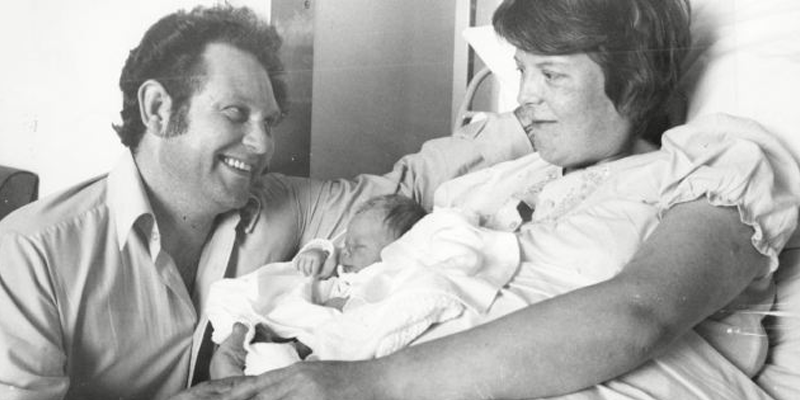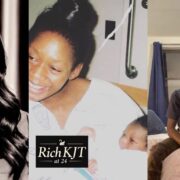First IVF Baby, Louise Joy Brown Tells The Remarkable Story Of Her Life 46 Years After

The birth of the world’s first IVF baby, in 1978, marked a groundbreaking milestone that revolutionized reproductive science.
Now, decades later, Louise Joy Brown is championing “Joy”, a new film that tells the remarkable story of how her life began and the pioneers who made it possible.
In Vitro Fertilisation (IVF) is a medical procedure used to assist individuals and couples struggling with infertility.
Derived from the Latin term in vitro, meaning “in glass,” IVF refers to the process of fertilising an egg outside the body in a controlled laboratory environment.
ITV disclosed on Thursday that the new film tells the astonishing story of how the three pioneers of IVF battled widespread opposition.
Louise Joy Brown was born on July 25, 1978, with her middle name ‘Joy’ giving the Netflix movie its title. She’s often called the world’s first “test-tube baby”.
In 1978, headlines around the globe hailed her as the “test tube baby,” though, as Louise points out, it wasn’t a test tube but a desiccator bottle used in the groundbreaking process.
“Test tube baby” might have been a catchy headline, but what truly stuck was the awe and controversy surrounding her birth.
Louise’s birth, following a procedure pioneered in Britain, has been lauded among “the most remarkable medical breakthroughs of the 20th century.”
According to the News agency, the film ‘Joy’ delves into the decade-long struggle of the trio behind IVF: gynaecologist Patrick Steptoe, physiologist Robert Edwards, and embryologist Jean Purdy.
The trio started working on IVF in the late 1960s when Steptoe started collecting egg cells from women and using sperm to fertilize them artificially at the Centre for Human Reproduction in Oldham, near Manchester in northwest England.
He worked with Purdy and Edwards for almost a decade to try to help women get pregnant using the technique.
Facing fierce opposition from religious groups, ethical debates, and scientific challenges, they forged a path that brought hope to countless families.
The New York Times reported that the team made 100 unsuccessful attempts to implant embryos using volunteers before they were finally successful.
In 1977, Bristol couple Lesley and John Brown came to the clinic after trying for nine years to have a baby.
After implanting Brown with a fertilized embryo, Purdy was the first person to see the embryo’s cell division, which later became the Browns’ first child.
Brown reflected on their legacy during a visit to Bourn Hall, Cambridge, the fertility clinic the pioneers established in 1980.
“You can see their pride in every story of success that followed,” she said, her voice tinged with gratitude.
Brown’s parents became unlikely history-makers alongside her.
“They were working-class people,” she shared, explaining why they were chosen for the experimental treatment.
Their story highlights the persistent inequalities in IVF access today, with many NHS patients facing lengthy waiting times and soaring costs for private care.
Brown is an ambassador for IVF, and is “passionate about breaking the silence on all things fertility and ending the taboo about getting help for fertility issues or being born through scientific means,” according to her website.
She lives in Bristol and has two sons who were conceived naturally.
In an interview at Bristol’s Old Vic Theatre this year to coincide with the play “A Child of Science,” Brown said:
“Steptoe and Edwards were like grandfathers to me growing up. Patrick died when I was quite young; I last saw him when we did the Wogan show together, and he held my hand alongside other babies that he and Bob had brought into the world at Bourn Hall Clinic in Cambridgeshire, which they opened after my birth.”
She added,
“Bob Edwards I was able to get to know as an adult. He came to my wedding and was the first person I rang when I got pregnant after my parents. I knew him and his family as friends. Unfortunately, Jean Purdy died at the age of 39 and I did not know her.”
Purdy died in 1985.
Inspiration: Seven rounds of IVF
Writers Jack Thorne and Rachel Mason, who underwent seven rounds of IVF before welcoming their son, bring a deeply personal perspective to Joy.
“IVF is still not taken seriously enough,” Rachel said. “People with fertility struggles deserve access to medical treatment, but IVF is often dismissed as a luxury or middle-class pursuit.”
She pointed to a recent report linking failed IVF cycles to PTSD, underscoring the emotional toll.
The film ‘Joy’ also aims to correct historical omissions. At its heart is Jean Purdy, the world’s first embryologist, whose critical role in IVF’s creation was largely erased from history.
Purdy, who died at 39 of cancer without children of her own, was an essential force in the success of the treatment.
“It’s tragic how little recognition she received,” said actor Bill Nighy, who plays Patrick Steptoe.
“She worked in a male-dominated field where fertility science was considered second-class.”
By putting Purdy at the forefront, ‘Joy’ honours her pivotal contributions and celebrates the determination of the many women who underwent early treatments, paving the way for IVF advancements.
“This film isn’t just about the science,” Brown remarked. “It’s about the humanity, the struggles, and the triumphs that brought us here.”
For Louise, Joy is more than a film—it’s a testament to how far IVF has come and a call to address the disparities that remain.
Decades after her birth made headlines, she hopes it will inspire renewed appreciation for those who helped make the miracle of life possible for so many.



